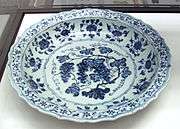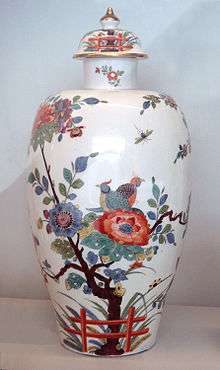Wedgwood
 | |
| Successor | WWRD Group Holdings Ltd |
|---|---|
| Founded | 1759 |
| Founder | Josiah Wedgwood |
| Headquarters | Stoke-on-Trent, England |
Key people | Pierre de Villeméjane (CEO) |
Number of employees | 3,100 |
| Parent | Fiskars Corporation |
| Website |
www |
Josiah Wedgwood and Sons, commonly known as Wedgwood, is a fine china, porcelain, and luxury accessories company founded on 1 May 1759[1] by Josiah Wedgwood.
In 1987, Wedgwood merged with Waterford Crystal to create Waterford Wedgwood, an Ireland-based luxury brands group. Waterford Wedgwood was purchased by the New York City-based private equity firm KPS Capital Partners in 2009, and became part of a group of companies known as WWRD Holdings Ltd., an acronym for "Waterford Wedgwood Royal Doulton." On 2 July 2015, Fiskars Corporation acquired WWRD.
History
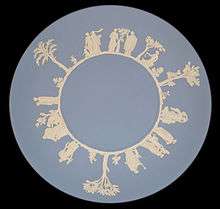
At the outset, Josiah Wedgwood worked with the established potter Thomas Whieldon until 1759 when relatives leased him the Ivy House in Burslem, Stoke-on-Trent, which allowed him to start his own pottery business. His marriage to Sarah Wedgwood, a distant cousin with a sizable dowry, helped him launch his new venture.
In 1765, Wedgwood created a new form of earthenware, which impressed the then British Queen consort Charlotte of Mecklenburg-Strelitz who gave official permission to call it "Queen's Ware." This new form sold extremely well across Europe. In 1766, Wedgwood bought Etruria, a large Staffordshire estate, as both a home and factory site. Wedgwood developed a number of further industrial innovations for his company, notably a way of measuring kiln temperatures accurately and the new ware types Black Basalt and Jasper Ware.

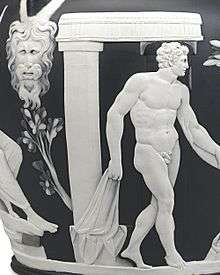
Wedgwood's best known product is jasperware created to look like ancient cameo glass. It was inspired by the Portland Vase, a Roman vessel which is now a museum piece. The first jasperware color was Portland Blue, an innovation that required experiments with more than 3,000 samples. In recognition of the importance of his pyrometric beads (pyrometer), Josiah Wedgwood was elected a member of the Royal Society in 1783. The Wedgwood Prestige collection sold replicas of the original designs as well as modern neo-classical style jasperware.
The main Wedgwood motifs in jasperware, as well–as in other wares like basaltware, queensware, caneware, etc.–were decorative designs that were highly influenced by the ancient cultures being studied and rediscovered at that time, especially as Great Britain was expanding its empire. Many motifs were taken from ancient mythologies: Roman, Greek and Egyptian. Meanwhile, archaeological fever caught the imagination of many artists. Nothing could have been more suitable to satisfy this huge business demand than to produce replicas of ancient artefacts. Many representations of royalty, nobles and statesmen in silhouette were created, as well as political symbols. These were often set in jewellery, as well as in architectural features like fireplace mantels, mouldings and furniture. Wedgwood has honoured American individuals and corporations as well, both historically and recently. In 1774 he employed the then 19-year-old John Flaxman as an artist, who would work for the next 12 years mostly for Wedgwood. The "Dancing Hours" may be his most well known design. Other artists known to have worked for Wedgwood include among others Lady Elizabeth Templetown, George Stubbs, Emma Crewe and Lady Diana Beauclerk.
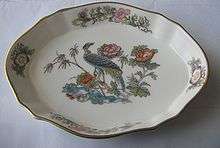
Wedgwood had increasing success with hard paste porcelain which attempted to imitate the whiteness of tea-ware imported from China, an extremely popular product amongst high society. High transport costs and the demanding journey from the Far East meant that the supply of chinaware could not keep up with increasingly high demand. Towards the end of the 18th century other Staffordshire manufacturers introduced bone china as an alternative to translucent and delicate Chinese porcelain.[2] In 1812 Wedgwood produced their own bone china[3] which, though not a commercial success at first[2] eventually became an important part of an extremely profitable business.

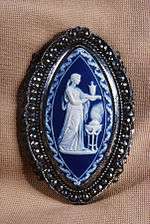
Josiah Wedgwood was also a patriarch of the Darwin–Wedgwood family. Many of his descendants were closely involved in the management of the company down to the time of the merger with the Waterford Company:
- John Wedgwood, eldest son of Josiah I, was a partner in the firm from 1790 to 1793 and again from 1800 to 1812.
- Josiah Wedgwood II (1769–1843), second son of Josiah I, succeeded his father as proprietor in 1795 and introduced the production by the Wedgwood company of bone china. In 1815, during Josiah II's time as proprietor, the great English Romantic poet William Blake (1757–1827) spent time engraving for Wedgwood's china catalogues.[5]
- Josiah Wedgwood III (1795–1880), son of Josiah II, was a partner in the firm from 1825 until he retired in 1842.
- Francis Wedgwood, son of Josiah II, was a partner in the firm from 1827 and sole proprietor following his father's death until joined by his own sons. Financial difficulties caused him to offer for sale soon after taking over the firm its factory at Etruria and the family home Etruria Hall, but in the event and fortunately for the company only the hall was sold. He continued as senior partner until his retirement to Barlaston Hall in 1876.
- Godfrey Wedgwood (1833–1905), son of Francis Wedgwood, was a partner in the firm from 1859 to 1891. He and his brothers were responsible for the reintroduction of bone china c.1876 and the employment of the artists Thomas Allen and Emile Lessore.
- Clement Wedgwood (1840–1889), son of Francis Wedgwood, was a partner.
- Laurence Wedgwood (1844–1913), son of Francis Wedgwood, was a partner.
- Major Cecil Wedgwood DSO (1863–1916), son of Godfrey Wedgwood, partner from 1884, first Mayor of the federated County Borough of Stoke-on-Trent (1910–1911), was chairman and managing director of Wedgwood until his death in battle in 1916.
- Kennard Laurence Wedgwood (1873–1949), son of Laurence Wedgwood, was a partner. In 1906 he went to the United States and set up the firm's New York office, which became Josiah Wedgwood and Sons USA, an incorporated subsidiary, in 1919.
- Francis Hamilton Wedgwood (1867–1930), eldest son of Clement Wedgwood, was chairman and managing director from 1916 until his sudden death in 1930.
- Josiah Wedgwood V (1899–1968), grandson of Clement Wedgwood and son of Josiah Wedgwood, 1st Baron Wedgwood, was managing director of the firm from 1930 until 1968 and credited with turning the company's fortunes around. He was responsible for the enlightened decision to move production to a modern purpose built factory in a rural setting at Barlaston. It was designed by Keith Murray in 1936 and built between 1938 and 1940. He was succeeded as managing director by Arthur Bryan (later Sir Arthur), who was the first non-member of the Wedgwood family to run the firm.
Enoch Wedgwood (1813–1879), a distant cousin of the first Josiah, was also a potter and founded his own firm, Wedgwood & Co, in 1860. It was taken over by Josiah Wedgwood & Sons in 1980.
In 1968, Wedgwood purchased many English potteries including Mason's Ironstone, Johnson Brothers, Royal Tuscan, William Adams & Sons, J. & G. Meakin and Crown Staffordshire. In 1979, Waterford Wedgwood purchased the Franciscan Ceramics division of Interpace in the United States. The Los Angeles plant closed in 1984 and production of the Franciscan brand was moved to Johnson Brothers in Britain. In 1986, Waterford Glass Group plc purchased Wedgwood plc forming the company Waterford Wedgwood.
Waterford Wedgwood
In 1986, Waterford Glass Group plc purchased Wedgwood plc for US$360 million, with Wedgwood delivering a 38.7 million USD profit in 1998 (while Waterford itself lost $28.9 million) after which the group was renamed Waterford Wedgwood. From early 1987 to early 1989, the CEO was Patrick Byrne, previously of Ford, who then became CEO of the whole group. During his time, he sold off non-core businesses, and reduced the range of Wedgwood patterns from over 400 to around 240. In the late 1990s, the CEO was Brian Patterson. From 1 January 2001, the Deputy CEO was Tony O'Reilly, Junior, who was appointed CEO in November of the same year and resigned in September 2005. He was succeeded by the then president of Wedgwood USA, Moira Gavin up until the company went into administration in 2009.
In 2001 Wedgwood launched a collaboration with designer Jasper Conran which started with a white fine bone china collection then expanded to include seven patterns. In March 2009, KPS Capital Partners acquired Waterford Wedgwood group assets. Assets including Wedgwood, Waterford and Royal Doulton were placed into WWRD Group Holdings Ltd.
WWRD Group Holdings
On 5 January 2009, following years of financial problems at group level, and after a share placement failed during the global financial crisis of 2008, Wedgwood was placed into administration[6] on a "going concern" basis, with 1,800 employees remaining. On 27 February 2009, Waterford Wedgwood's receiver Deloitte announced that the New York-based private equity firm KPS Capital Partners had purchased certain Irish and UK assets of Waterford Wedgwood and the assets of its Irish and UK subsidiaries.[7] In March 2009, KPS Capital Partners announced that it had acquired group assets in a range of countries, including the UK, USA and Indonesia, would invest €100 million, and move a number of jobs to Asia to cut costs and return the firm to profitability.[8] In a move that had begun under the previous owners, approximately 1,500 jobs were cut in the UK, leaving 800 workers in the UK producing only the high-end Wedgwood products.[9] KPS Capital Partners has placed Wedgwood into a group of companies known as WWRD, an acronym for "Waterford Wedgwood Royal Doulton."
On 11 May 2015 in a deal expected to close July 2015, the Fiskars Corporation, a Finnish maker of home products, agreed to buy 100% of the holdings of WWRD.[10] On 2 July 2015 the acquisition of WWRD by Fiskars Corporation was completed including brands Waterford, Wedgwood, Royal Doulton, Royal Albert and Rogaška. The acquisition was approved by the US antitrust authorities.[11]
Wedgwood Museums and the Museum Trust
Wedgwood's founder wrote as early as 1774 that he wished he had preserved samples of all the company's works, and began to do so. The first formal museum was opened in May 1906, with a curator named Isaac Cook, at the main (Etruria) works. The contents of the museum were stored for the duration of the Second World War and relaunched in a gallery at the new Barlaston factory in 1952. A new purpose-built visitor centre and museum was built in 1975 and remodelled in 1985 with pieces displayed near items from the old factory works in cabinets of similar period. A video theatre was added and a new gift shop as well as an expanded demonstration area where visitors could watch pottery being made. A further renovation costing £4.5 million was carried out in 2000, including access to the main factory itself, following which the visitor centre complex won multiple awards.
Adjacent to the museum and visitor centre are a restaurant and tea room, serving on Wedgwood ware. The museum, managed by a dedicated trust, closed in 2000 and on 24 October 2008 reopened in a new multimillion-pound building.
In June 2009, the Wedgwood Museum won a UK Art Fund Prize for Museums and Art Galleries for its displays of Wedgwood pottery, skills, designs and artefacts.[12] In May 2011, the archive of the museum was inscribed in UNESCO's UK Memory of the World Register.[13][14][15]
The Minton Archive is a separate part of the collection. It comprises papers and drawings of the designs, manufacture and production of the pottery company Mintons covering the period 1793–1968 and the artistic and industrial archives of Royal Doulton.[16]
The collection with 80,000 works of art, ceramics, manuscripts, letters and photographs faced being sold off to help satisfy pension debts inherited when Waterford Wedgwood plc went into receivership in 2009. The Heritage Lottery Fund, the Art Fund, various trusts and businesses contributed donations to purchase the collection.[17] On December 1 2014, the collection was purchased and donated to the Victoria and Albert Museum. The collection will continue to be on display at the Wedgwood Museum on loan from the Victoria and Albert Museum.[18]
Wedgwood locality
Wedgwood railway station was opened in 1940 to serve the Wedgwood complex in Staffordshire, England.
Notes and references
- ↑ "Pottery firm marks 250th birthday". BBC. 1 May 2005. Retrieved 1 May 2009.
- 1 2 Brian Dolan, Wedgwood: The First Tycoon, Viking 2004, p335
- ↑ The Grove Encyclopedia of Decorative Arts, ed. Campbell, OUP 2006, Volume 2, p547
- ↑ "Belt Clasp with a Female Making a Sacrifice". The Walters Art Museum.
- ↑ Michael Davis, William Blake: A New Kind of Man, University of California Press, 1977, pages 140–141
- ↑ "Wedgwood goes into administration". BBC. 5 January 2009.
- ↑ "Waterford Wedgwood bought by US equity firm KPS Capital". The Irish Times. 27 February 2009. Retrieved 27 February 2009.
- ↑ Arnold, Martin (26 March 2009). "New Wedgwood owner to invest €100m". Financial Times. London. Retrieved 26 March 2009.
- ↑ "Waterford Wedgwood shifts to Asia to save company | The Jakarta Post". thejakartapost.com. 2012. Retrieved 19 April 2012.
- ↑ Bray, Chad. "Fiskars Agrees to Buy Owner of Waterford and Wedgwood". New York Times. Retrieved 11 May 2015.
- ↑ "Fiskars Corporation has completed the acquisition of WWRD and extended its portfolio with iconic luxury home and lifestyle brands". NASDQ Global News Wire. Retrieved 6 July 2015.
- ↑ "Wedgwood wins £100,000 art prize". BBC. 18 June 2009. Retrieved 5 November 2009.
- ↑ "2011 UK Memory of the World Register", United Kingdom National Commission for UNESCO, 2011. Accessed 4 June 2011.
- ↑ "Wedgwood Museum archive recognised by UNESCO," Wedgwood Museum. Accessed 4 June 2011.
- ↑ "Unesco recognises Wedgwood Museum archive collection", BBC, 24 May 2011. Accessed 4 June 2011.
- ↑ "Art Fund helps save the Minton Archive for the nation" (PDF). Art Fund. Retrieved 21 June 2015.
- ↑ "Wedgwood collection 'saved for nation'". BBC. Retrieved 10 March 2015.
- ↑ "Loan of Wedgwood Collection to Barlaston finalised". Save the Wedgwood Collection. Retrieved 10 March 2015.
External links
| Wikimedia Commons has media related to Josiah Wedgwood and Sons. |
- Official Wedgwood UK website
- Official Wedgwood website
- Wedgwood Museum
- Save the Wedgwood Museum Campaign
- Wedgwood Society of Boston
- Wedgwood Waterford
- Wedgwood buttons, made 1785–1800, from the Victoria & Albert Museum jewellery collection.
- Sydney Cove Medallion at the National Museum of Australia
